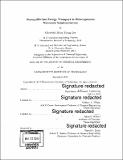Nonequilibrium energy transport in heterogeneous nanoscale semiconductors
Author(s)
Lee, Elizabeth Moon Young.
Download1103314716-MIT.pdf (18.27Mb)
Other Contributors
Massachusetts Institute of Technology. Department of Chemical Engineering.
Advisor
William A. Tisdale and Adam P. Willard.
Terms of use
Metadata
Show full item recordAbstract
Modern optoelectronic devices such as photovoltaics and LEDs operate based on transport of nanoscale energy carriers. Promising material for these devices are assemblies of nanometer-sized semiconductors, including quantum dots (QD) and organic conjugated polymers. Unlike crystalline semiconductors that are homogenous in energy and space, there exist static and dynamical heterogeneity in nanoscale semiconductors. To control energy transport and improve their device efficiencies, this thesis presents nonequilibrium energy transport models to understand the effect of nanoscale heterogeneity on material-wide optoelectronic properties with emphasis on excitons. At first, continuum-level analytical theories and finite element simulations are employed to derive exciton distributions in semiconductor films. These models are applied to transient photoluminescence interfacial quenching experiments of CdSe QD thin film interface to measure exciton diffusion length. A linear elasticity theory is constructed to understand the effect of surface ligands on low-frequency vibrations of colloidal QDs. This theory combined with Raman spectroscopy allows measurement of elastic properties of surface bound ligands that are otherwise challenging to probe. Next, a nonequilibrium exciton dynamics model developed at the coarse-grained level is used to investigate energy transport in disordered QD solids. Through kinetic Monte Carlo and chemical master equation simulations combined with time-resolved spectroscopy techniques, this model reveals that static energetic disorder causes ensemble-averaged exciton diffusivity to decrease over time such that the net diffusivity is reduced relative to the ordered case. A subsequent model based on resonance energy transfer theory discovers scenarios in which there can be disorder-enhanced incoherent energy transport. Such enhancements can be important in processes that are sensitive to molecular-scale fluctuations. Finally, the role of dynamical disorder due to the environment in the case of organic conjugated polymers in solution is interrogated: the interplay between thermal fluctuations and excited state forces drives exciton migration along the polymer backbone. Simulation results are verified with anisotropy decay measurements of poly(3-hexylthiophene). To simulate exciton transport in large systems like long-chain conjugated polymers, a constrained adiabatic dynamics method is developed. Application of this method highlights that failure to preserve wavefunction symmetry while preventing trivial unavoided problem in an adiabatic dynamics simulation can create unphysical electronic dynamics.
Description
Thesis: Ph. D., Massachusetts Institute of Technology, Department of Chemical Engineering, 2018 Cataloged from PDF version of thesis. Includes bibliographical references.
Date issued
2018Department
Massachusetts Institute of Technology. Department of Chemical EngineeringPublisher
Massachusetts Institute of Technology
Keywords
Chemical Engineering.